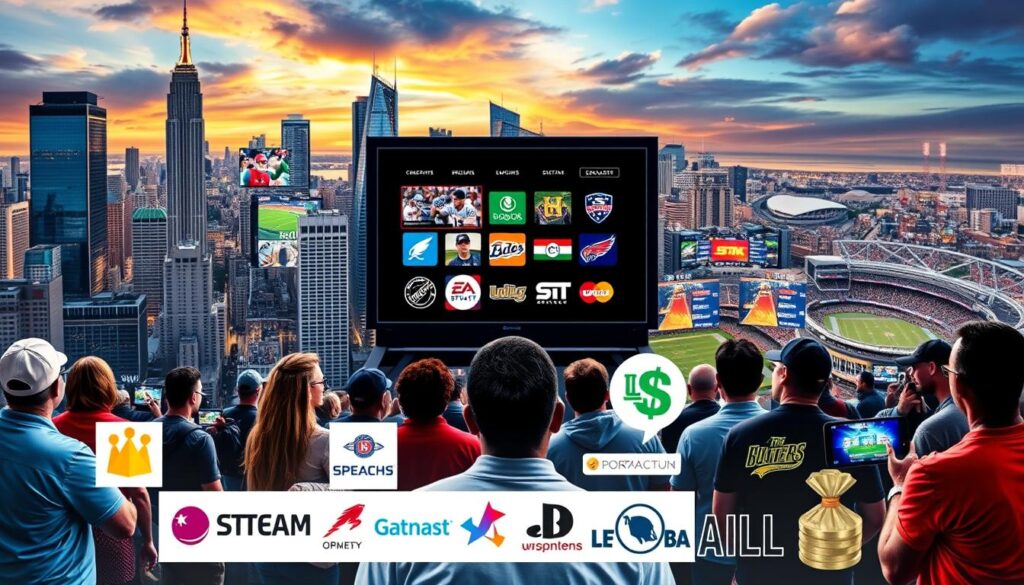“Change is the law of life. And those who look only to the past or present are certain to miss the future.” John F. Kennedy’s words highlight how streaming is changing the sports broadcasting landscape. Services like ESPN+, Amazon Prime Video, and Peacock are not just changing how we watch sports. They are also changing the impact of streaming services on sports media rights deals.
Streaming has brought big changes, like the ACC Network airing about 1,300 events a year. This includes 40 football games and other college sports since 20191. Streaming has made sports more accessible and customizable, with options like Sling TV and DIRECTV STREAM1. This shift lets you watch sports on your own terms, perfect for today’s viewers.
More people want on-demand sports, leading to a new era of competition. Streaming is changing the sports industry and making traditional networks rethink their plans. As we dive into this, it’s clear that knowing these changes is key to understanding sports content’s future.
Introduction to Sports Media Rights
Sports media rights are key in today’s broadcasting world. They allow broadcasters to show sports events. These rights come in forms like national, local, and digital, each important for leagues and teams’ income.
Broadcasting partnerships are now more crucial than ever. More companies want these rights. This affects leagues, teams, and sponsors a lot. Over time, how these rights are negotiated has changed a lot. This is due to new tech, audience tastes, and money matters.
The money side of owning rights is huge. For example, viewer engagement notifications have gone way up2. This shows a big change in how people watch sports and what broadcasters need to do.
Understanding sports media rights is complex. But it’s vital. The field keeps evolving with new tech and how we watch sports. Staying updated is key to grasping the future of sports broadcasting.
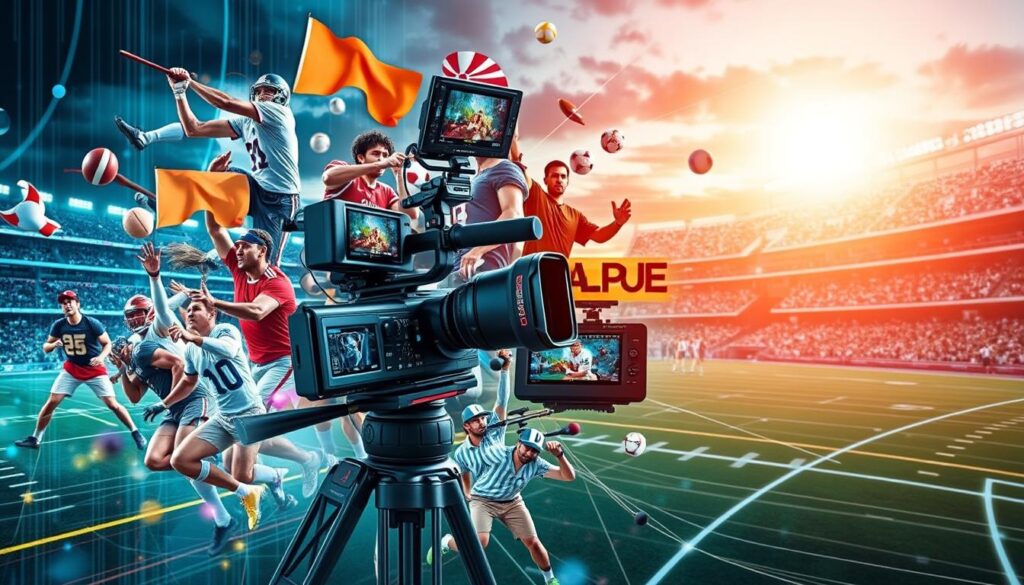
The Rise of Streaming Services in Sports
Streaming services have changed how we watch sports. Platforms like Hulu Live, YouTube TV, and DAZN have become popular. They have changed how people watch sports.
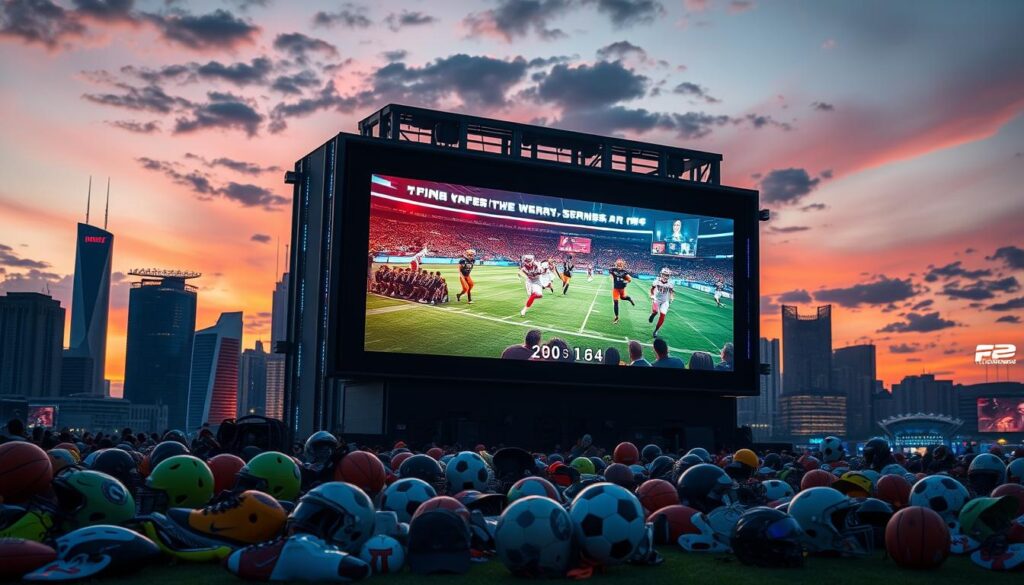
More people now prefer streaming over traditional TV. Studies show over 70% of sports fans like streaming better. This is because streaming lets viewers watch live sports whenever they want.
In the last decade, streaming services have grown a lot. Subscriptions have gone up by almost 50% every year. This shows how popular streaming is and how sports fans are getting younger and more into technology.
Streaming services are changing how sports leagues sell their rights. This makes leagues think about digital distribution more. It also makes people wonder if traditional TV will still be popular as streaming grows3.
Impact of Streaming Services on Sports Media Rights Deals
Streaming services have changed the game in sports media rights deals. They offer new ways to watch sports and make the competition fiercer. This has changed how deals are made and valued.
Traditional broadcasters are now facing a new world. The role of streaming services in sports media rights deals is clear.
How Streaming Platforms Have Altered Negotiations
Streaming platforms have changed media rights talks by making competition for sports content even tighter. Rights holders are now using digital platforms more. This has led to big investments in exclusive rights.
These deals are getting more expensive and changing how contracts are renewed. The whole process is becoming more dynamic.
The Role of Major Players in the Streaming Market
Big names like Amazon and Apple are getting more sports rights. They’re making a big impact in the market. Their moves push traditional broadcasters to be more creative to stay ahead.
This competition helps sports leagues get more money. It’s changing how sports are watched and making streaming services key players in the future.
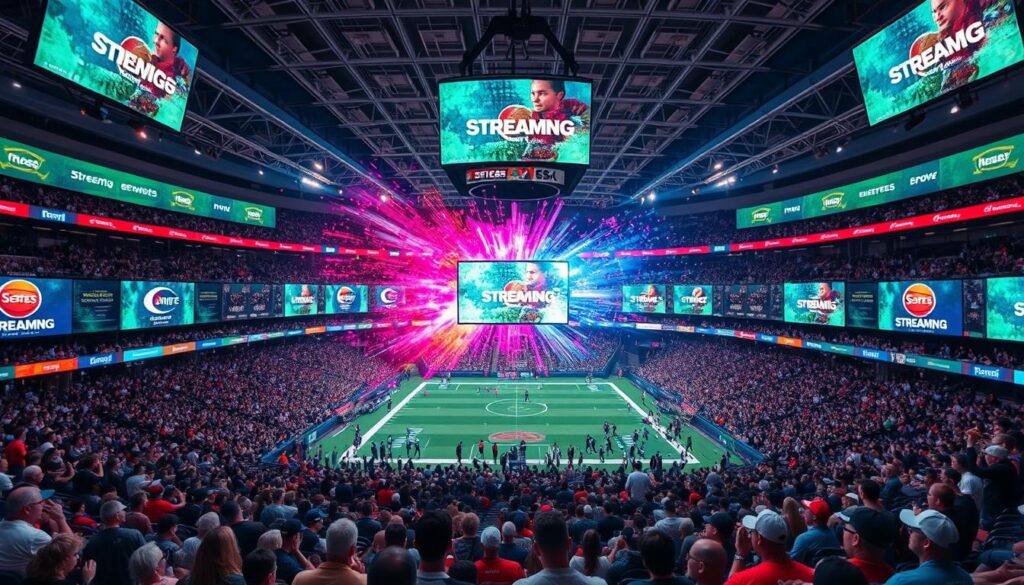
Traditional Sports Broadcasting vs. Streaming Services
The way we watch sports is changing, moving from traditional TV to streaming services. For years, TV has been the main way to watch sports, with set times and big networks like ESPN and NBC. These networks make money from ads and viewership.
Now, streaming services like Hulu Live and YouTube TV offer a new way to watch sports. They let you watch games whenever you want, not just when they’re on TV. Young people like this because it’s easy and doesn’t require a long cable contract.
Streaming also changes how ads are shown. Unlike TV, which has ads during breaks, streaming ads are less in your face. This makes watching sports more enjoyable and personal.
Here’s a table showing the main differences between traditional TV and streaming:
| Feature | Traditional Broadcasting | Streaming Services |
|---|---|---|
| Content Accessibility | Fixed schedules, limited flexibility | On-demand access, high flexibility |
| Viewership Experience | Commercial breaks, scheduled viewing | Minimal interruption, customized viewing |
| Advertising Strategy | Traditional ads, time slots | Integrated ads, tailored experiences |
| Target Audience | General demographic, established viewers | Young adults, tech-savvy consumers |
People are now choosing convenience and personalization over traditional TV. This shift shows a big change in how we watch sports. It’s making both TV and streaming change to meet our needs.

The debate between TV and streaming is ongoing. Knowing the differences will help shape the future of sports media. You might choose between them based on what you like best4.
Subscription-Based Services and Their Influence
Subscription-based services have changed how sports fans watch games. More people are choosing these services over traditional cable. This change is driven by new technology and the desire for personalized content.
Consumer Behavior Towards Subscription Models
Studies show more viewers like subscription services over old TV. These services offer flexibility, cost savings, and unique content. Almost 75% of young people prefer them5.
This shift is making advertisers change their ways. They’re moving from TV to digital platforms. This lets them reach fans more effectively.
Brands are now teaming up with big streaming services. They’re reaching more people and different groups. About 45% of sports fans might switch for better viewing6.
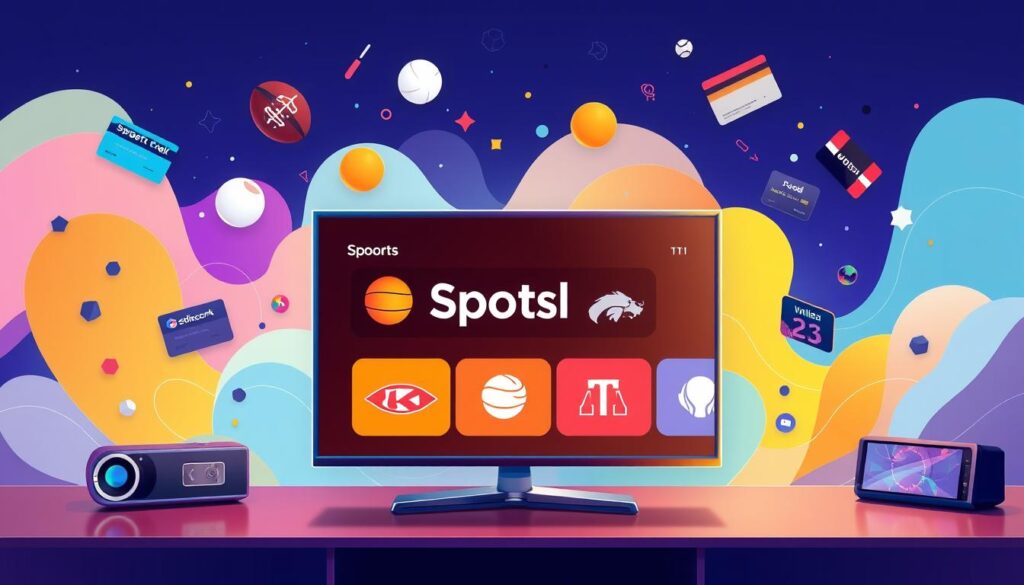
This change is making media rights holders rethink their plans. They need to get better deals to keep up. These services are not just changing how we watch sports. They’re also changing how the industry makes money7.
Digital Media Trends Shaping the Sports Industry
The sports world is changing fast, thanks to digital media trends. Social media is key, letting fans talk to players and each other right away. It creates a community feeling and helps teams connect with fans in new ways.
Technology is also changing sports marketing. Teams use data to know their fans better, making interactions more personal. For example, watching games on mobile devices has grown, bringing in more viewers and money.

New tech like virtual and augmented reality is making sports more exciting. It offers fans a deeper experience, which younger viewers love. As sports evolve, keeping up with these trends is vital for staying relevant and growing8910.
| Digital Media Trend | Description | Impact on Sports |
|---|---|---|
| Social Media Engagement | Platforms for fan interaction and news dissemination | Stronger community feeling, real-time updates |
| Mobile Streaming | Access to live sports via smartphones and tablets | Increased viewership, flexibility for fans |
| Data Analytics | Using data to personalize fan experiences and marketing | Targeted marketing strategies, improved engagement |
| Virtual and Augmented Reality | Immersive experiences for fans | Enhanced viewing, innovative marketing opportunities |
The Role of Tech Giants in Sports Broadcasting
Amazon and Apple have changed sports broadcasting a lot. They use their big resources and new ideas to make sports content better. This makes old broadcasters work harder to keep up.
Amazon, Apple, and the Future of Sports Streaming
Amazon and Apple have bought a lot of sports rights. They offer sports shows that are as good as the old ones. They make watching sports online better with smooth streams and cool features.
This big change affects how we watch sports and how the sports world makes money. These companies want more special content. This means how sports rights are sold and valued might change a lot.

Here are some important points about tech giants in sports broadcasting:
- Innovative streaming technologies.
- Exclusive content deals with leagues and teams.
- Enhanced viewer engagement through interactive features.
| Company | Strategic Moves | Impact on Sports Broadcasting |
|---|---|---|
| Amazon | Acquisition of NFL Thursday Night Football | Increased viewership on streaming platforms |
| Apple | Partnerships with Major League Baseball | Enhanced accessibility for fans |
As streaming gets better, tech giants will play a big part in sports broadcasting. They will help sports shows meet new viewer needs and tech. Experts say we will see big changes that will change how we watch sports.
Sports Industry Disruption by Streaming
The sports world is changing fast because of streaming. Fans now get to watch sports when they want, not just when it’s on TV. This change makes leagues rethink how they make money.
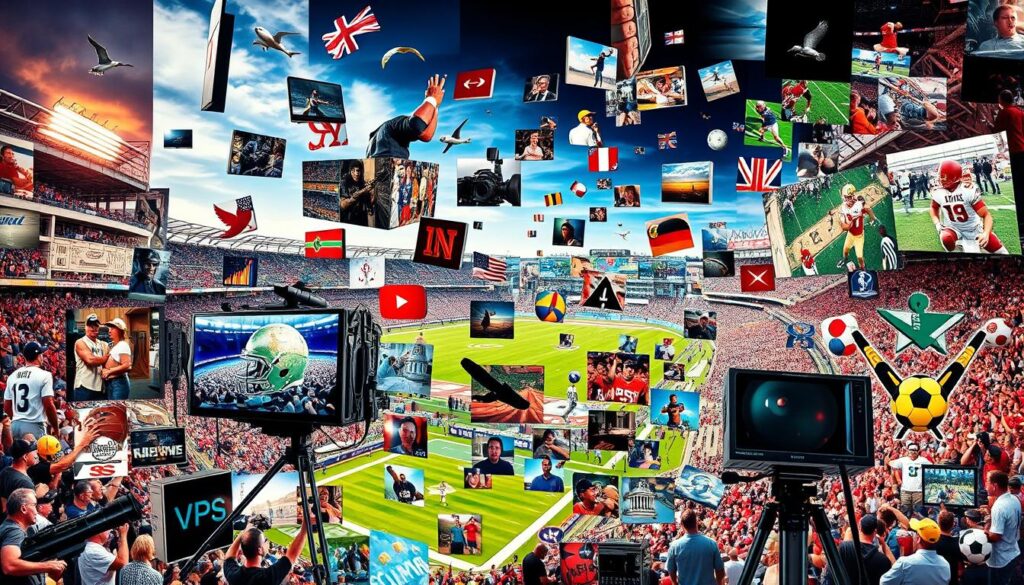
More people are watching sports online, which is changing how sponsors pay for ads. Brands are now teaming up with digital platforms instead of TV. In 2022, the NFL made more money from digital deals than from TV contracts.
League leaders know they must change with the times. They’re finding new ways to work and make money. Streaming services like Amazon Prime and Apple TV are becoming key players in sports.
| Aspect | Traditional Broadcasting | Streaming Services |
|---|---|---|
| Viewership Flexibility | Fixed schedules | On-demand access |
| Audience Engagement | Passive watching | Interactive features |
| Revenue Generation | Advertisement-based | Subscription and ad-supported models |
| Sponsorship Opportunities | Limited to broadcast slots | Diverse digital partnerships |
The sports world is changing fast because of streaming. This change brings new chances and challenges for everyone involved. It’s important for leagues and fans to adapt to these changes.
Streaming is becoming more popular, but we’re still seeing how it will change sports. The mix of sports and technology is changing how we watch games and making sports broadcasting different.
“The transformation brought on by streaming is not merely an adaptation; it’s a revolution that demands all stakeholders to rethink their strategies.” – Industry Expert
As the sports world keeps changing, it’s key to stay up to date. This knowledge helps us deal with the challenges of this fast-changing field11.
Online Sports Viewing Behavior: A Shift in Audience Habits
The world of sports media is changing fast. It’s key for everyone involved to understand how people watch sports online. Studies show a big change in how fans watch sports. Now, many prefer to watch on-demand, whenever they want.

Social media has also changed how we watch sports. Sites like Twitter, Facebook, and Instagram give us updates and highlights. This makes watching sports more fun and interactive.
This change helps brands reach their audience better. It’s a win-win for everyone.
The table below shows some interesting facts about watching sports online:
| Statistic | Percentage |
|---|---|
| Viewers preferring live streaming over traditional TV | 60% |
| Individuals who watch sports via mobile devices | 45% |
| Households with subscription services for sports content | 70% |
| Viewers who engage in social media during sporting events | 55% |
The move to live streaming and mobile watching is big. It changes how sports are watched and marketed. Knowing these changes helps everyone in the sports world do better.
“The future of sports viewing lies in the hands of the audience, who increasingly prioritize convenience and accessibility.”
With more people wanting live streaming, the sports world must keep up. Adapting to these changes is key for everyone. It ensures sports fans get what they want12.
Media Rights Negotiations in the Streaming Era
The world of media rights has changed a lot with streaming. Now, sports leagues and fans have new choices. The NBA just got TV deals worth US$76 billion, showing how valuable these deals can be13.
Big names like Amazon and ESPN are changing how deals are made. Amazon got a deal with Rogers Communications for NHL games in Canada. This move shows how streaming is changing sports broadcasting14.
Teams and leagues are feeling the effects. The MLB is setting up a local media division to make more money from media rights. Local deals are helping teams’ values go up13.
Traditional broadcasters are struggling to keep up with digital demand. U.S. pay-TV providers lost over 5 million subscribers in 2023. This is making them rethink their strategies15.

The next big deal in broadcasting is coming soon. NHL Commissioner Gary Bettman thinks it could be a “big payday”. The focus will be on exclusive rights and new platforms. This will shape the future of media rights negotiations14.
Challenges for Traditional Broadcast Networks
Traditional broadcasters are facing big challenges in today’s digital world. The way people watch sports has changed, making it harder for them to compete with streaming services. With more people watching on demand, networks need new ways to keep viewers and make money from ads.
Adapting to the New Digital Landscape
Networks are trying different ways to stay relevant. For example, Altitude TV started streaming games online because of issues with cable providers16. This shows how important it is to offer flexible viewing options to keep up with viewer expectations17.
Also, using data to create personalized content is becoming key. Networks are investing in fan data to improve marketing and engagement17. As they adapt to the digital world, their success will depend on how well they adjust.
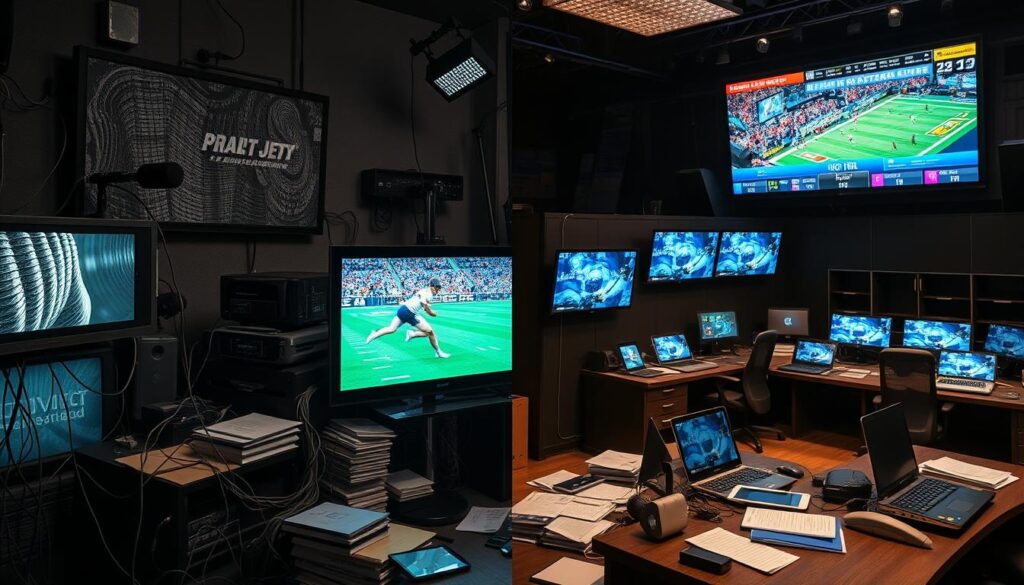
Future of Sports Content Distribution
Looking ahead, virtual reality and augmented reality will change how we watch sports. These technologies will make fans feel like they’re right in the action. It’s a big change that will make watching sports more exciting and personal13.
Streaming services are getting better, with features like betting odds and interactive stats. This shift shows how sports content is changing. Experts say we’ll see more connected TV and interactive formats that keep viewers engaged17.
The sports world is moving online, and personalizing the experience is key. By understanding what viewers like, teams can make content that’s just right. This mix of tech and creative content is set to make sports broadcasting even more exciting18.

